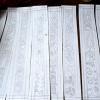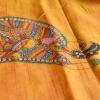The first choice any artist makes is the subject of the painting, no matter what the material - paper or fabric. Once that is decided and sketched out roughly with pencil, the shapes and figures are outlined with black paint using nib-pens (brush, in case of fabric). Then these are filled with natural dyes and pigments (now being replaced by fabric colorsfor their longevity) using brushes, twigs and fingers. Generally no space is left empty; the gaps are filled with flowers, animals, birds and even geometric designs.
Though there are no class of artists and most of the subjects are common, the different schools of Madhubani paintings have been classified into three types:
Kachni style of painting employs only one or two colors, black and vermillion. The artists rely on delicate fine lines enlivened with a variety of patterns using hatching and stippling. Kachni literally means ‘line’. This style is usually practiced by the Kayasta community in particular.
Bharni style of painting employs bold black outlines to clearly define the subject. The enclosed areas are filled with vibrant colors. The style is flat with no attempt at creating depth or ‘shading’. Bharni literally means ‘filling’. This style is practiced by the Brahmin community in particular.
Godhana style consists of small stick like figures geometrically organized in parallel lines, concentric circles or rectangles. Some of the paintings are then filled with color, others simply drawn in black. Some of the artists use a gobar wash on the paper, creating a background closer to that of the wall paintings. Tattoo paintings are generally painted by the Dusadh community.



